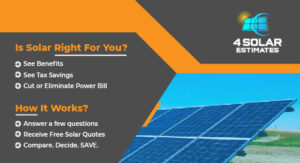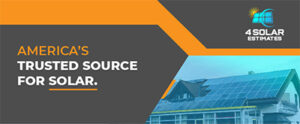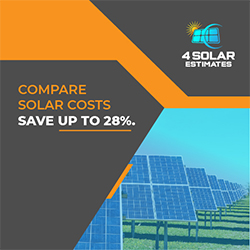
Tips for Achieving Energy Independence with Solar Panels
Energy independence is a growing trend among homeowners who want to reduce their reliance on fossil fuels, decrease their carbon footprint, and save money on their energy bills. Solar panels are an excellent way to achieve energy independence, as they convert sunlight into clean, renewable electricity. In this blog, we’ll explore tips for achieving energy independence with solar panels, from choosing the right system to maximizing your energy production.
COMPARE SOLAR QUOTESAssess Your Energy Needs
Before investing in solar panels, it’s crucial to understand your household’s energy needs. Evaluate your energy consumption by examining your utility bills and identifying any energy-saving opportunities. This will help you determine the size of the solar system you’ll need to achieve energy independence.
Choose the Right Solar Panel System
There are several types of solar panel systems available, each with its advantages and disadvantages. To achieve energy independence, consider the following factors when choosing a solar system:
- Grid-tied vs. off-grid: Grid-tied systems are connected to the utility grid, allowing you to use grid power when your solar panels aren’t producing enough electricity. Off-grid systems, on the other hand, rely solely on solar power and battery storage, making them ideal for achieving energy independence.
- Solar panel efficiency: Higher efficiency panels produce more electricity per square foot, which can help you achieve energy independence with a smaller system.
- Battery storage: Integrating battery storage into your solar system enables you to store excess energy for use during cloudy days or at night, increasing your chances of achieving energy independence.
Optimize Your Solar Panel Placement
The placement of your solar panels plays a significant role in your system’s energy production. To maximize your solar panels’ efficiency:
- Orientation: In the Northern Hemisphere, solar panels should face south to capture the most sunlight throughout the day.
- Tilt angle: Adjust the tilt angle of your solar panels to match your latitude for optimal energy production.
- Shade: Minimize shading from trees, buildings, or other obstructions to ensure your solar panels receive maximum sunlight.

Implement Energy Conservation Measures
Achieving energy independence with solar panels requires not only generating renewable energy but also reducing your overall energy consumption. Implement the following energy conservation measures to make the most of your solar power:
- Upgrade to energy-efficient appliances: Energy Star-certified appliances consume less energy and can help you achieve energy independence.
- Seal air leaks: Properly sealing your home’s windows, doors, and other openings can significantly reduce heat loss and energy consumption.
- Insulate your home: Adding insulation to your home’s walls, attic, and floors can help maintain a comfortable temperature and decrease your energy use.
- Install a smart thermostat: A smart thermostat can optimize your heating and cooling system’s efficiency, reducing energy waste.
Regularly Maintain Your Solar Panels
Regular maintenance is crucial to ensure your solar panels’ optimal performance and longevity. Keep your solar panels clean and free of debris, and schedule regular inspections to identify and address any potential issues.
COMPARE SOLAR QUOTESMonitor Your Solar System’s Performance
Monitoring your solar system’s performance can help you identify any dips in energy production and make necessary adjustments to achieve energy independence. Many solar panel systems come with monitoring software that allows you to track your energy production and consumption in real time.
By following these tips and investing in a solar panel system, you can take a significant step toward achieving energy independence. Not only will you be reducing your reliance on fossil fuels and decreasing your carbon footprint, but you’ll also enjoy long-term savings on your energy bills. With solar power, you can enjoy a more sustainable, self-sufficient lifestyle while contributing to a cleaner, greener future.

Exploring the 3 Main Types of Solar Panels
When it comes to solar panels, not all are created equal. There are three main types of solar panels available in the market, each with its unique characteristics, advantages, and disadvantages. To help you make an informed decision for your energy independence journey, let’s explore these three main types of solar panels: monocrystalline, polycrystalline, and thin-film.
Monocrystalline Solar Panels
Monocrystalline solar panels are made from a single crystal structure, which gives them their recognizable uniform dark black color. These panels are known for their high efficiency and long lifespan.
Advantages:
- High efficiency: Monocrystalline solar panels typically have the highest efficiency rates among all solar panel types, ranging from 17% to 22%. This means they can generate more electricity per square foot, making them ideal for space-constrained installations.
- Long lifespan: Monocrystalline solar panels often come with a 25-year warranty or more, thanks to their durable construction and high-quality materials.
- Better performance in low-light conditions: These panels are known to perform better in low-light conditions compared to other solar panel types, making them a good choice for areas with less sunlight.
Disadvantages:
- Higher cost: Monocrystalline solar panels tend to be more expensive due to their high-quality materials and manufacturing process. However, their higher efficiency and longer lifespan can make them a worthwhile investment in the long run.
Polycrystalline Solar Panels
Polycrystalline solar panels are made from multiple silicon crystals that have been melted together, giving them a distinctive blue hue. These panels are a more affordable option but generally have lower efficiency rates than monocrystalline panels.
Advantages:
- Lower cost: Polycrystalline solar panels are typically less expensive than monocrystalline panels, making them a popular choice for budget-conscious homeowners.
- Environmentally friendly manufacturing: The manufacturing process for polycrystalline solar panels is less energy-intensive and produces less waste, making them a more environmentally friendly option.
Disadvantages:
- Lower efficiency: Polycrystalline solar panels usually have efficiency rates between 15% and 17%, which is lower than monocrystalline panels. This means you may need more space to install enough panels to achieve your energy independence goals.
- Shorter lifespan: These panels may have a slightly shorter lifespan compared to monocrystalline panels, although they still typically come with a 25-year warranty.

Thin-Film Solar Panels
Thin-film solar panels are made by depositing a thin layer of photovoltaic material onto a substrate, such as glass, plastic, or metal. These panels have a sleek appearance and are lightweight, but they generally have the lowest efficiency rates of the three types.
COMPARE SOLAR QUOTESAdvantages:
- Low cost: Thin-film solar panels are often the most affordable option, making them attractive for large-scale installations or budget-conscious homeowners.
- Flexibility: Some thin-film panels are flexible, which can be useful for unique or curved installation surfaces.
- Aesthetics: Thin-film panels have a sleek, uniform appearance that some homeowners find more visually appealing than the appearance of crystalline panels.
Disadvantages:
- Low efficiency: Thin-film solar panels typically have efficiency rates between 10% and 12%, which is significantly lower than both monocrystalline and polycrystalline panels. This means you’ll need more space to install a sufficient number of panels to achieve energy independence.
- Shorter lifespan: Thin-film solar panels generally have a shorter lifespan compared to crystalline panels, often with warranties ranging from 10 to 25 years. However, this can vary depending on the specific thin-film technology used.
When considering which type of solar panel to choose, it’s important to weigh the advantages and disadvantages of each option, taking into account factors such as your budget, available space, and aesthetic preferences.
Average Cost of Solar Panels
The cost of solar panels can vary widely depending on factors such as the type of panel, the size of the system, and the location of the installation. However, here are some average cost ranges to give you a general idea of what to expect:
- Monocrystalline solar panels: $1.00 to $1.50 per watt
- Polycrystalline solar panels: $0.80 to $1.20 per watt
- Thin-film solar panels: $0.60 to $1.00 per watt
To calculate the total cost of a solar panel system, you’ll need to consider the cost per watt of the panels, the size of the system (measured in watts or kilowatts), and any additional costs for equipment, installation, and permits. For example, if you were to install a 5-kilowatt monocrystalline solar panel system at $1.25 per watt, the total cost of the panels would be $6,250. However, when you factor in the additional costs, the overall price of the system could range from $10,000 to $15,000 or more. Keep in mind that there are federal and state incentives, such as tax credits and rebates, that can help offset the cost of solar panels. Be sure to research the incentives available in your area and factor them into your budget when considering a solar panel system.
Achieving energy independence with solar panels requires careful consideration of your energy needs, the type of solar panel that best suits your situation, and your budget. By understanding the differences between the three main types of solar panels and their associated costs, you can make an informed decision that will help you reduce your reliance on fossil fuels, decrease your carbon footprint, and save money on your energy bills in the long run.
COMPARE SOLAR QUOTES
Leave a Reply